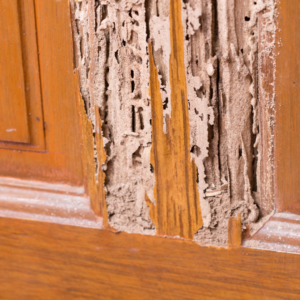All over Texas, hidden beneath the soil, lurks a pest with a peculiar appetite for wood: the subterranean termite. As the weather warms from winter into spring, the winged members of termite colonies, known as swarmers, take flight.
Seeing termites in the natural world isn’t always a bad thing. Subterranean termites are a valuable part of our overall ecosystem. They break down cellulose into usable nutrients, enrich the soil, and support the health of all that grows and lives in it. Unfortunately, while that’s great for nature, subterranean termites make for horrible houseguests.
How much does termite damage cost homeowners? 
Finding out you have a termite infestation is more than a mere nuisance, as the wood-chewing insects can eat you out of your house and home. In 2019, the estimated cost of termite damage to homes was more than $5 billion! Being proactive by having regular inspections can help save your home from being added to this statistic.
Side note: Termites will straight up just eat your money if given a chance. Check out this video to see what we mean!
Texas is home to the two types of termites responsible for an estimated 90% of that damage: the native subterranean termite and the Formosan termite. Formosan termites can be found throughout the southeastern United States and are highly troublesome due to their aggressive colonization. While a native subterranean termite infestation is terrifying enough, Formosan colonies are much larger, allowing them to do more damage in less time. With such an enormous colony, this particular type of subterranean termite is a challenge to treat and control.
What are the signs of termite infestation?
While being proactive when it comes to termites is ideal, things happen. How do you know if you have subterranean termites? Unlike drywood termites, subterranean termites don’t leave behind frass. Frass is the technical term for droppings left behind by drywood termites and other boring insects.
To find out if you have subterranean termites, you’ll need to look for less obvious signs. Formosan and subterranean termite swarmers (the flying part of the colony) tend to lose their wings as part of their natural maturation process. As a result, you’ll find their wings around windows or collected in cobwebs. Dead termite bodies may also be found in indoor lights. Swarmers come out in spring and summer in Texas, so this is when you are more likely to see them in and around your house. 
Another thing to keep an eye out for is mud tubes. Subterranean termites live underground, just as the name suggests. However, to make their way from their underground colony to their next food source, they create above-ground tunnels called mud tubes. Termites need moisture to survive, and mud tubes allow them to stay in a dark, moist environment while on the move.
The tubes are built from a mixture of soil, wood, and saliva. Some mud tubes utilize cracks in your home’s foundation, keeping them hidden, but you may also find mud tubes around foundation walls, subfloors, window frames or sills, and joists. The presence of mud tubes means subterranean termites are an issue that needs professional evaluation.
Tunnels also form inside the wood as termites chew it away, giving it almost a honeycomb-type texture. It may look completely normal outside, so don’t rely on a visual cue whether or not termites are present. However, it’s possible to tell if the wood has a hollow sound by tapping it with a screwdriver. Of course, we think it’s best to leave the determination to the experts.
How do you prevent termites in new construction?
If you haven’t built your home yet, you can’t look for termites around window sills or in cobwebs. And if it’s not swarming season, you’re unlikely to find them just walking the property. So the best way to protect your new home is with a pre-construction treatment before you decide to build. Fortunately, we can help with that.
How horrible would it be to find out you just planned to build a home right on top of a massive colony of Formosan or subterranean termites? You might not even find out until it’s too late. There are other factors to consider here, too. Specific locations are more prone to water accumulation, and subterranean termites are attracted to that.
855Bugs offers Wood Destroying Insect inspections giving homeowners peace of mind. Whether it’s a new construction or just a home that’s new to you, the 855Bugs WDI Warranty is extendable and renewable for up to a year. If you find any active termites during your coverage period, treatment costs are covered. You can even transfer your WDI Warranty to a new owner should you sell your home.
Click here for more information on our WDI inspection reports and to schedule one today.




